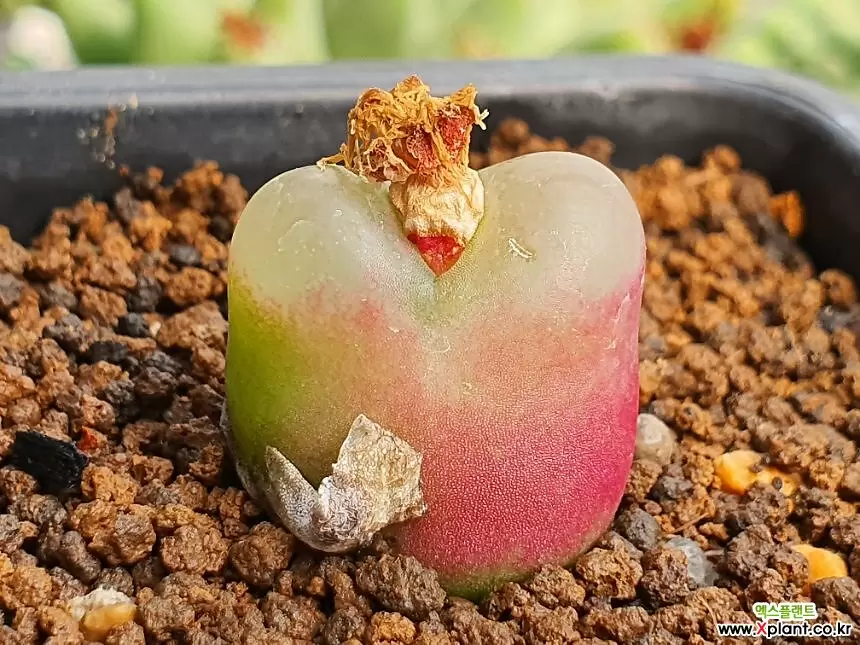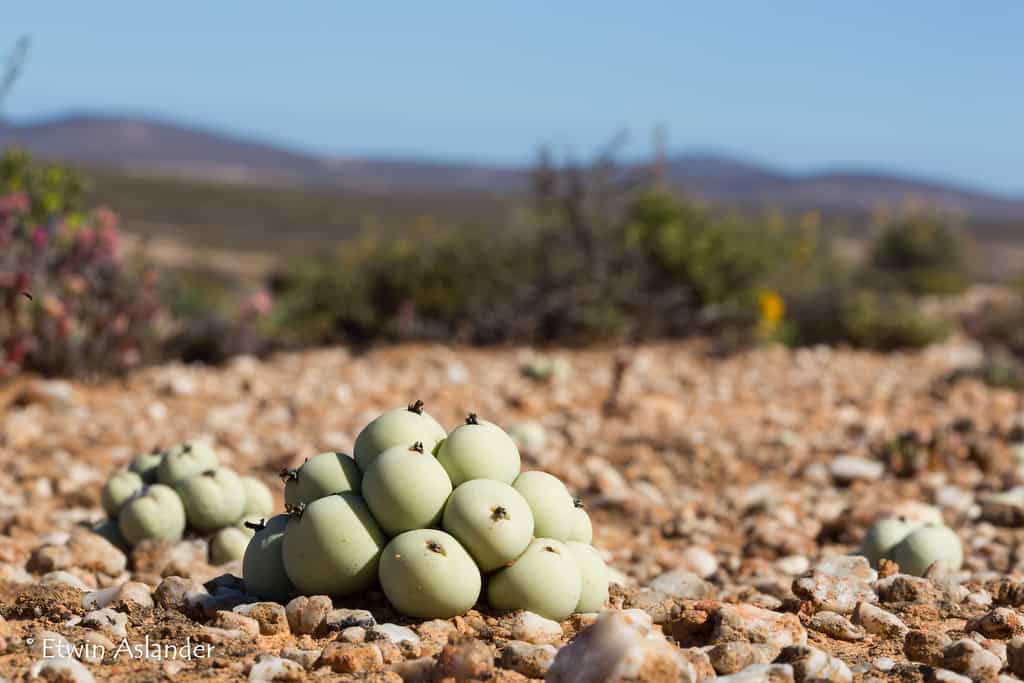Conophytum maughanii, or cono as they are often called, are small and fascinating South African succulents that have become very popular in recent years due to their low-maintenance requirements and stunning coloration. However, because they’re popular, they can be tricky to find at your local garden center or nursery!
The best place to buy conos is online through grower sites, where you can order plants directly from the grower and get live plants shipped to your door!
Conophytum maughanii has become popular among succulent gardeners in recent years due to its attractive leaf color and ease of care.
This drought-tolerant succulent makes an excellent beginner plant because it’s resilient to typical succulent care mistakes, such as overwatering and underfeeding, as well as fun to grow from seed.
You’ve just purchased your first succulent (Conophytum maughanii), and you’re so excited to add it to your garden! But how do you care for it properly?
Here are the basics of conophytum maughanii care and propagation tips, as well as instructions specific to this succulent variety.
Origin and distribution
Conophytum maughanii is a species of succulent plant native to South Africa. The population in its known habitat has been reduced by over 50% since 2003 and as such, Conophytum maughanii is listed as vulnerable by the IUCN Red List of Threatened Species.
The area where Conophytum maughanii grows has been declared a nature reserve but unfortunately, illegal poaching still occurs despite increased security measures put in place to protect these unique plants from extinction. Due to its rarity, Conophytum maughanii is one of the most expensive succulents available on today’s market.
If you are lucky enough to own one of these beautiful and rare plants, take good care of it! It will reward you with many years of enjoyment if you follow some simple rules regarding its cultivation and propagation.
Conophytum maughanii propagation
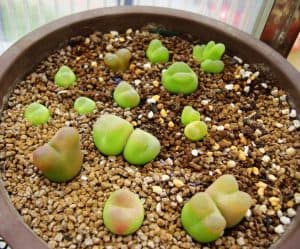
Conophytums can be propagated by division. If your plant is in a container, simply pull it out of its pot and break off several branches and replant them directly into their own pots, leaving some space between each new cutting to allow room for growth.
Alternatively, you can use a sharp knife to slice large segments of leaves from your plant; leave one or two sets of leaf nodes on each segment and re-plant them into their own pots. These should root within a few weeks.
To divide your plant, dig up an entire clump with as many roots as possible and divide it into individual plants using a sharp knife.
Plant these in their own containers, leaving plenty of space between each new conophytum to ensure they have enough room to grow. It’s best to wait until spring or summer before dividing your conophytum plants.
Conophytum maughanii care information
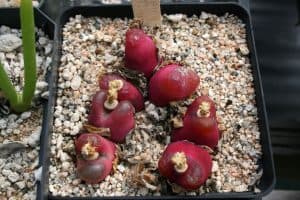
Conophytums are winter growers and are dormant during summer. They prefer more water than other succulents, but should not be kept in standing water. If a plant is too wet, it will often develop root and stem rot which kills it very quickly.
On that note, they also do not like their soil to dry out completely; keep it on the moist side but not soggy or wet (keep them in a bright window). The best way to tell if your conophytum needs watering is by checking its leaves. If they look shriveled or curled up, then you need to water them.
When watering your conophytums, make sure you get all of its roots wet as well as any of its body parts above ground level. This can be done by placing your potted conophytum in a tray of shallow water for about 10 minutes before removing it from the tray and allowing excess water to drain off.
Light requirement
Conophytums are native to South Africa, where they receive intense sunshine during their growing season. In order to grow successfully indoors, conophytums need a lot of light. Place them in a south-facing window and provide at least four hours of sunlight per day; they will not be damaged by more intense light but may overheat, which can cause damage that looks like rot or fungus.
Conophytums enjoy bright, indirect sunlight, so if you keep yours in an area that only gets partial sun (particularly in winter), consider switching them to a brighter location and bringing them inside during cooler months.
Soil/potting mix
Conophytums grow well in cactus potting mix or African violet soil, which are available from local gardening stores. If you have trouble finding these products, you can also prepare your own mix with one-part organic matter such as peat moss, two parts potting soil, and two parts sand.
Watering
Young conophytums are more tolerant of under-watering than most succulents, but it’s still important to water them correctly. Unlike many other types of succulents, they prefer being allowed to dry out almost completely before being watered again.
Fertilizer
It’s important to fertilize your Conophytum maughanii at least once a month during their growing season (between fall and spring). Use a slow-release fertilizer, like Osmocote, which releases nutrients slowly over time instead of all at once. Follow package instructions on how much to use; too much or too little can both harm your plant.
To be safe, try using one-quarter of what’s recommended in a 3-5 gallon pot. If you want to go organic, add composted cow manure to your soil as well. Make sure it’s completely broken down before adding it to your plants so that they don’t get burned by its high nitrogen content.
If you have access to worm castings or compost tea, these are great ways to add organic matter into your soil without harming your plants with excess nitrogen.
Temperature
Native to South Africa, Conophytum maughanii are succulents and like it hot. They need bright light and grow best in temperatures between 75-80 degrees Fahrenheit (24-27 degrees Celsius). If you’re growing them indoors, use a grow light or place them near a sunny window.
Conophytums also need good drainage, so make sure their pots have holes in them for water to drain out of. It’s also important that they don’t sit in water—you can put gravel at the bottom of their pots if you think they might be sitting in too much water.
Humidity
Conophytum maughanii do not require high humidity to thrive, and in fact, conditions that are too humid can cause spotting and other damage. A light misting of a room humidifier or placing your plants on a pebble tray once or twice a week is sufficient for most conos.
The ideal humidity range is between 40 and 60 percent. Water when soil feels dry to touch, but don’t let it get bone dry.
Pruning
You can also remove dead leaves by pruning, which is a lot easier than trying to pull them off. Use clean, sharp pruning shears, and be careful not to damage other parts of your plant while you’re at it.
Pinching: To encourage branching in your conophytum maughanii, simply pinch out some of its tips with clean fingers or scissors.
This will help promote more growth from where you pinched.
When to repot
If your conophytum maughanii starts looking like it needs more room to grow, repotting may be necessary. This should only happen every two years or so; if done too often, it could kill your plant. When repotting, use a pot that’s only one size larger, if you go up two sizes, you might as well start over with a new plant.
The best time to repot Conophytum maughanii is during late winter, and early spring. If you choose to repot in summer, it can be done as long as temperatures are not too hot.
Newly repotted conophtyums should be left dry for about two weeks before watering and a layer of mulch placed around them so they don’t dry out completely. After that, water regularly but do not overwater.
Dormancy
Conophytum maughanii do not like to be disturbed and will go dormant if given too much light, moved around too much, or exposed to temperatures that are too warm or cold.
That said, you may occasionally notice a few of your plants beginning to shrivel and fold up their leaves (this is called abscission) even when conditions seem optimal. This means they are going dormant; leave them alone until they begin growing again in spring.
They are one of those species that prefer cooler temperatures, so it’s best to keep it on a windowsill or other area where it won’t get direct sunlight for most of the day.
If you live in an area with cold winters, it’s best to store your plant somewhere cool and dry during dormancy—but don’t forget about it! Once new growth begins in spring, place your plant back outside where it can receive plenty of sun during daylight hours.
Flowers & Fragrance
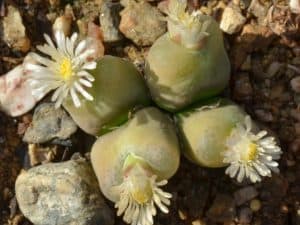
The flowers of conophytum maughanii are small, with a red-orange color, and appear in summer. The flowers smell rather unpleasant to humans but have been described as smelling like peppermint and vanilla.
Growth rate
Conophytum maughanii are slow growers. This is one of their most appealing features for many enthusiasts, you can have a plant that’s been in your collection for decades.
The smallest plants will only grow to about 1 inch tall and 4 inches wide, but some of these tiny balls can live 10 or 15 years. Expect it to take 3 to 5 years before you see flowers on your conophytum maughanii!
Toxicity
Despite its great beauty, Conophytum maughanii is toxic. It contains small amounts of both cardiac glycosides and saponins, which can be fatal to pets or small children if ingested.
Take care to keep your new plant out of reach of children and any animals who might accidentally consume it. If you have curious little ones at home, be sure to keep all plants (even those from outdoors) locked away in a secure area until you’re sure that all have been identified properly.
USDA Hardiness Zones
Conophytum maughanii will thrive in USDA hardiness zones 9b-11. However, it is important to note that these plants do not do well when exposed to temperatures below freezing.
If you live in a colder climate, it is recommended that you grow your conophytums indoors during the winter months and then transplant them outside once temperatures have warmed up. Alternatively, if you are unable to keep your plant alive through the winter months, you can always purchase new plants each spring.
Pests and diseases
To keep your conophytums healthy, you should take steps to ensure they don’t fall prey to pests and diseases. For example, you can use an insecticide on your cactus if it is infested with mealybugs or scale insects. Conophytums are also susceptible to fungus, so make sure there’s plenty of light in their growing area and that humid conditions don’t cause mold.
If a plant does become infected, remove it from its pot and wash off any debris before repotting into fresh soil. You may need to replace some plants every year due to disease or pest damage; otherwise, your collection will grow quickly over time.
Conclusion
Conophytum maughanii is a fairly easy succulent to grow. It requires little maintenance, and it’s a very versatile plant that looks great in indoor and outdoor gardens.
This particular species can be an excellent choice for newbie gardeners who are looking for an easy-to-grow addition to their collection. While growing, Conophytum maughanii may take some time, it’s well worth it when you see how beautiful your specimen grows!
